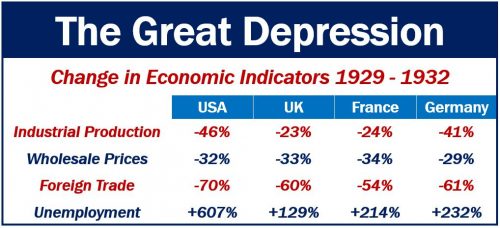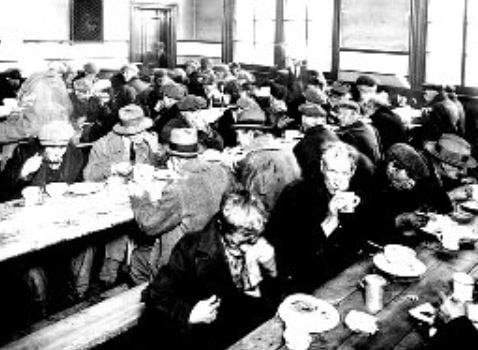The Great Depression was the most severe economic downturn in modern history. In the United States, it lasted from 1929 to 1939. It started after the Wall Street Crash in October 1929. In that month, investors went into a panic, and millions of people lost all their money. In this article, ‘modern history’ refers to the history of the world since the end of the 19th century.
For several years after the Wall Street Crash, investment and consumer spending declined considerably. This caused steep falls in employment and industrial output.
By 1933 in the United States, unemployment had reached 15 million, i.e., 20% of the country’s population. Also by 1933, half the country’s banks had failed.
The Great Depression vs. the Great Recession
In modern history, the two most serious economic downturns were the Great Depression and the Great Recession.
The Great Recession followed the Global Financial Crisis of 2007/8. In the United States, for example, the Great Recession lasted from December 2007 to June 2009. The United Kingdom’s economy was in recession from the end of 2008 to the end of 2009.
The Great Depression of the 1930s was much more severe and longer-lasting than the Great Recession.

Difference between a depression and a recession
The Federal Reserve Bank of San Francisco says that there is no standard answer to that question.
Recession
Journalists say that a recession exists when a country’s economy has two consecutive quarters of negative GDP growth. GDP stands for gross domestic product.
Economists’ definition of a recession differs. The National Bureau of Economic Research describes a recession as follows:
“A recession is a significant decline in economic activity spread across the economy, lasting more than a few months, normally visible in real GDP, real income, employment, industrial production, and wholesale-retail sales.”
“A recession begins just after the economy reaches a peak of activity and ends as the economy reaches its trough.”
Depression
Even though there is no standard definition of depression, we understand it as a more severe version of a recession.
Nicholas Gregory Mankiw, an American macroeconomist, currently the Robert M. Beren Professor of Economics at Harvard University, once wrote:
“There are repeated periods during which real GDP falls, the most dramatic instance being the early 1930s. Such periods are called recessions if they are mild and depressions if they are more severe.”
Some economists say that a depression is a recession that lasts more than three years.
The Great Depression – a global crisis
The Great Depression began in the United States after the Wall Street Crash and then spread to other countries.
Global GDP
From 1929 to 1932, global GDP declined by approximately 15%. This was a much serious downfall than the 1% global GDP decline from 2008 to 2009 during the Great Recession.

Some countries’ economies started recovering in the mid-1930s. In many economies, however, the negative and harmful effects of the Great Depression lingered until the start of WWII.
According to Wikipedia:
“The Great Depression had devastating effects in countries both rich and poor. Personal income, tax revenue, profits and prices dropped, while international trade plunged by more than 50%. Unemployment in the U.S. rose to 25% and in some countries rose as high as 33%.”
“Cities around the world were hit hard, especially those dependent on heavy industry. Construction was virtually halted in many countries.”
Farming
As crop prices crashed, in many cases falling by as much as 60%, farmers and rural areas suffered significantly. The economic downturn affected virtually every sector of many nations’ economies.
Video – What is an Economic Depression?
